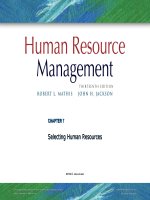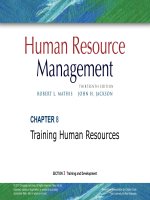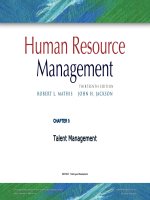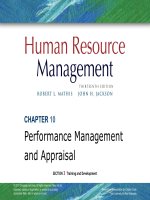Human resrouce management 13th mathis jacson chapter 04
Bạn đang xem bản rút gọn của tài liệu. Xem và tải ngay bản đầy đủ của tài liệu tại đây (1.64 MB, 37 trang )
CHAPTER 4
Workers, Jobs, and Job Analysis
SECTION 2 Jobs and Labor
© 2011 Cengage Learning. All rights reserved. May not be
scanned, copied or duplicated, or posted to a publicly
accessible Web site, in whole or in part.
PowerPoint Presentation by Charlie Cook
The University of West Alabama
Chapter Objectives
After you have read this chapter, you should be able to:
• Explain how the diversity of the workforce affects HR management
functions.
• Identify components of work flow analysis that must be considered.
• Define job design and identify common approaches to varying job
design.
• Describe different types of work teams and HR facets that must be
considered.
• Discuss how telework and work flexibility are linked to work-life
balancing efforts.
• Describe job analysis and the stages and methods used in the
process.
• List the components of job descriptions.
Workforce Composition
• Changes in the U.S. Workforce
Increases in health care and health-related jobs
Declines in manufacturing jobs and workers
Increased need for workers with technical skills
Increasing diversity in the workforce
• Diversity
Differences in human characteristics and composition
in an organization
Race/ethnicity • National origin/immigration
Age/generational differences • Sexual orientation
Gender • Marital and family status
Disabilities • Religion
Business Contribution of Diverse Workers
• “Business Case” for Diversity:
Allows new talent and ideas from employees of
different backgrounds, which can enhance
organizational performance.
Helps recruiting and retention because protected-
class individuals often prefer to work in organizations
with coworkers of various demographics.
Allows for an increase of market share because
customers can be attracted to purchase products and
services with varied demographic marketing activities.
Can lead to lower costs because there may be fewer
discrimination lawsuits.
FIGURE 4–1
Various Approaches to Diversity and Their Results
Generational Differences
• Age/generational Groups:
Matures (born before 1946)
Baby boomers (born 1946–1964)
Generation Xers (born 1965–1980)
Generation Yers (millenials) (born 1981–2000)
• Challenges:
Older workers delaying retirement
Shortage of experienced and skilled workers
Generational differences in expectations from jobs
FIGURE 4–2
Positive Multigenerational Management Activities
Nature of Jobs and Work
• Dividing Work into Jobs
Work
Effort
directed toward producing or accomplishing
results.
Job
A grouping of tasks, duties, and responsibilities that
constitutes the total work assignment for an
employee.
Influences Affecting Jobs, People, and Related HR Policies
Organizational
Values
Organizational
Strategy
Customer
Needs
Nature of Work
Jobs
Needed
•
•
•
•
•
People Needed
for Jobs
HR Activities Focusing on Jobs
Job analysis• Recruiting
Training and development
Performance management
Health, safety, and security
Employee relations
• Compensation
Workflow Analysis
• Workflow Analysis
The study of the way work (inputs, activities, and
outputs) moves through an organization.
Inputs
Activities
Outputs
People, materials,
equipment
Tasks and
jobs
Goods and
services
Evaluation
Business Process Re-Engineering
• Business Process Re-engineering (BPR)
Measures for improving such activities as product
development, customer service, and service delivery.
Rethink
Redesign
Retool
Workers and Job Design
Full-time
employees
Part-time
employees
Types of
Workers
Independent
contractors
Temporary
workers
Contingent
workers
Job Design
• Job Design
Organizing tasks, duties, and responsibilities into a
productive unit of work.
• Person-Job Fit
Matching characteristics of people with characteristics
of jobs.
Job Design Impacts
Performance
Job Satisfaction
Physical and
Mental Health
FIGURE 4–3
Some Characteristics of People and Jobs
Common Approaches to Job Design
Job Design
Approaches
Job
enlargement
Job
enrichment
Job
rotation
Job
sharing
FIGURE 4–4
Job Characteristics Model
Using Worker Teams in Jobs
Types of Teams
SpecialPurpose Team
Self-Directed
Team
Virtual
Team
FIGURE 4–5
Encouraging Team Performance Success
Team Jobs
Advantages
Disadvantages
• Improved productivity
• Increased employee
involvement
• More widespread employee
learning
• Greater employee ownership of
problems
• Requires employees to be
“group oriented”
• Not appropriate for most work in
organizations
• Can be overused
• Difficult to measure team
performance
• Individual compensation
interferes with team concept
Telework
• Telework
Employees work via electronic telecommunications,
and internet means.
• Effects of Alternative Work Arrangements
More self-scheduling by employees
A shift to evaluating employees on results
Greater trust, less control and direct supervision
Legal issues related to state and federal laws
Career impacts of lack of direct contact (visibility)
FIGURE 4–6
Telework Advantages for Employers
Work Schedule Alternatives
Global Work
Schedule
Differences
Work
Schedule
Alternatives
Work
Schedules
Shift Work
and Compressed
Workweek
Job
Sharing
Flexible
Scheduling
The Nature of Job Analysis
• Job Analysis
A systematic way of gathering and analyzing
information about the content, context, and the human
requirements of jobs.
Work activities and behaviors
Interactions with others
Performance standards
Financial and budgeting impact
Machines and equipment used
Working conditions
Supervision given and received
Knowledge, skills, and abilities needed
FIGURE 4–7
Job Analysis
in Perspective
FIGURE 4–8
Typical Division of HR Responsibilities: Job Analysis









